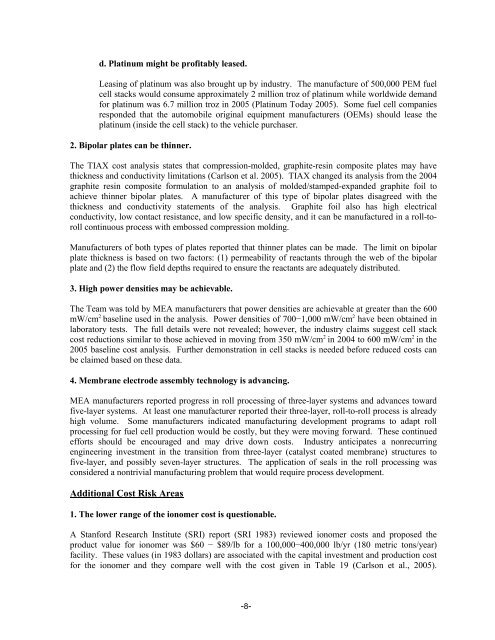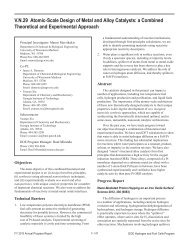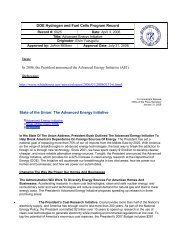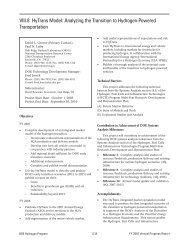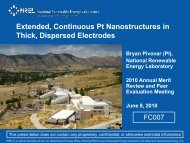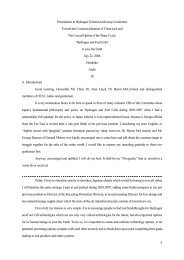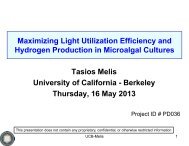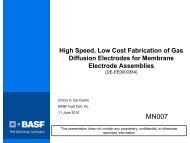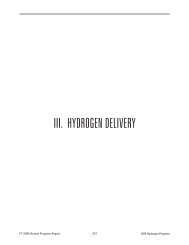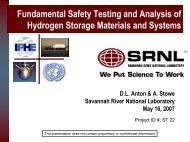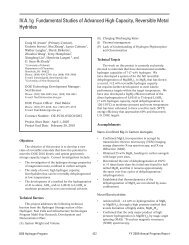Fuel Cell System for Transportation -- 2005 Cost Estimate
Fuel Cell System for Transportation -- 2005 Cost Estimate
Fuel Cell System for Transportation -- 2005 Cost Estimate
You also want an ePaper? Increase the reach of your titles
YUMPU automatically turns print PDFs into web optimized ePapers that Google loves.
d. Platinum might be profitably leased.<br />
Leasing of platinum was also brought up by industry. The manufacture of 500,000 PEM fuel<br />
cell stacks would consume approximately 2 million troz of platinum while worldwide demand<br />
<strong>for</strong> platinum was 6.7 million troz in <strong>2005</strong> (Platinum Today <strong>2005</strong>). Some fuel cell companies<br />
responded that the automobile original equipment manufacturers (OEMs) should lease the<br />
platinum (inside the cell stack) to the vehicle purchaser.<br />
2. Bipolar plates can be thinner.<br />
The TIAX cost analysis states that compression-molded, graphite-resin composite plates may have<br />
thickness and conductivity limitations (Carlson et al. <strong>2005</strong>). TIAX changed its analysis from the 2004<br />
graphite resin composite <strong>for</strong>mulation to an analysis of molded/stamped-expanded graphite foil to<br />
achieve thinner bipolar plates. A manufacturer of this type of bipolar plates disagreed with the<br />
thickness and conductivity statements of the analysis. Graphite foil also has high electrical<br />
conductivity, low contact resistance, and low specific density, and it can be manufactured in a roll-toroll<br />
continuous process with embossed compression molding.<br />
Manufacturers of both types of plates reported that thinner plates can be made. The limit on bipolar<br />
plate thickness is based on two factors: (1) permeability of reactants through the web of the bipolar<br />
plate and (2) the flow field depths required to ensure the reactants are adequately distributed.<br />
3. High power densities may be achievable.<br />
The Team was told by MEA manufacturers that power densities are achievable at greater than the 600<br />
mW/cm 2 baseline used in the analysis. Power densities of 700−1,000 mW/cm 2 have been obtained in<br />
laboratory tests. The full details were not revealed; however, the industry claims suggest cell stack<br />
cost reductions similar to those achieved in moving from 350 mW/cm 2 in 2004 to 600 mW/cm 2 in the<br />
<strong>2005</strong> baseline cost analysis. Further demonstration in cell stacks is needed be<strong>for</strong>e reduced costs can<br />
be claimed based on these data.<br />
4. Membrane electrode assembly technology is advancing.<br />
MEA manufacturers reported progress in roll processing of three-layer systems and advances toward<br />
five-layer systems. At least one manufacturer reported their three-layer, roll-to-roll process is already<br />
high volume. Some manufacturers indicated manufacturing development programs to adapt roll<br />
processing <strong>for</strong> fuel cell production would be costly, but they were moving <strong>for</strong>ward. These continued<br />
ef<strong>for</strong>ts should be encouraged and may drive down costs. Industry anticipates a nonrecurring<br />
engineering investment in the transition from three-layer (catalyst coated membrane) structures to<br />
five-layer, and possibly seven-layer structures. The application of seals in the roll processing was<br />
considered a nontrivial manufacturing problem that would require process development.<br />
Additional <strong>Cost</strong> Risk Areas<br />
1. The lower range of the ionomer cost is questionable.<br />
A Stan<strong>for</strong>d Research Institute (SRI) report (SRI 1983) reviewed ionomer costs and proposed the<br />
product value <strong>for</strong> ionomer was $60 − $89/lb <strong>for</strong> a 100,000−400,000 lb/yr (180 metric tons/year)<br />
facility. These values (in 1983 dollars) are associated with the capital investment and production cost<br />
<strong>for</strong> the ionomer and they compare well with the cost given in Table 19 (Carlson et al., <strong>2005</strong>).<br />
-8-


